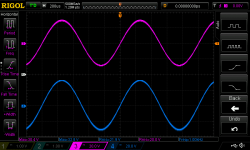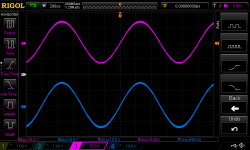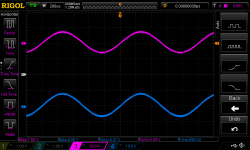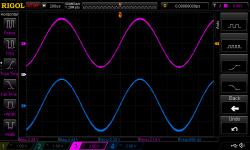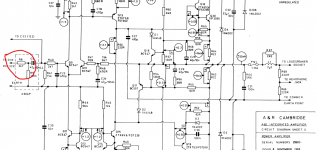I've got an Arcam A60 pulled from the bottom of a large pile of bought for a rainy day amps with a channel imbalance which increases with volume.
I've attached some scope screen shots to illustrate this please note the scopes voltage reading.
The amp has been recapped, no problems with this.
I have discounted the scope as it reads out on my meter as well and volume control as I have a spare alps blue that I've put in and it still reads the same, where to look next?
I've attached some scope screen shots to illustrate this please note the scopes voltage reading.
The amp has been recapped, no problems with this.
I have discounted the scope as it reads out on my meter as well and volume control as I have a spare alps blue that I've put in and it still reads the same, where to look next?
Attachments
Those four images from left to right show a gain imbalance of 0.4db, 0.72db, 0.86db and 0.55db.
The reality is its pretty good for a budget amp 🙂
(it is much safe to either just measure and set input voltage to be equal, for example on R8, and measure the output or link R8 between channels to force a mono condition)
The reality is its pretty good for a budget amp 🙂
(it is much safe to either just measure and set input voltage to be equal, for example on R8, and measure the output or link R8 between channels to force a mono condition)
Those four images from left to right show a gain imbalance of 0.4db, 0.72db, 0.86db and 0.55db.
This might seem a bit simple but I'm a little slow where maths is concerned, could you tell me the equation to work this out?
If you are concerned about channel imbalances of <1 db, you wouldn't have bought any consumer audio device in the first place. 'no harm in pursuing a professional or laboratory standard for your gear but don't be surprised that many audiophiles listen to and still enjoy even worse imbalance.
Before you take a hatchet to the relevant pots/resistors, check at other frequencies like 10 kHz and 100Hz, not just 1kHz. The L/R level disparity may not have a simple solution such as trimming the L/R balance adjustment with fixed or adjustable resistors.
BTW, if the imbalance increases with level disproportionately, guess where the problem actually is.....Yes, the volume pot L/R resistance tracks are not perfectly matched. That should not be any surprise, considering how difficult it is to make and match affordable, log. taper pot. resistance tracks.
Before you take a hatchet to the relevant pots/resistors, check at other frequencies like 10 kHz and 100Hz, not just 1kHz. The L/R level disparity may not have a simple solution such as trimming the L/R balance adjustment with fixed or adjustable resistors.
BTW, if the imbalance increases with level disproportionately, guess where the problem actually is.....Yes, the volume pot L/R resistance tracks are not perfectly matched. That should not be any surprise, considering how difficult it is to make and match affordable, log. taper pot. resistance tracks.
Last edited:
I would check the amp with the volume control at max and pad down the test signal. That way its a realistic test scenario, accounting for the preamp section's influence, but eliminating volume control mistracking as the main issue (which it often is, coupped with the balance control).
As others said, the channel imbalance you have now isn't that bad for this type/budget of amp. With a good ear you would easily be able to pick up on it, but its not an unreasonable amount compared to some other basic audio gear I've come across.
There's another voltage devider at the input of the power amp section which could be the culprit (or part of it). I'm willing to bet the main issue is coming from all the signal path before the amp, specifically all of the pots, including bass, treble, volume balance and loudness. You'd be shocked to see how bad lower grade dual ganged carbon pots mistrack, specifically volume and balance controls.
Maybe re-capping the preamp section with mactched pairs of capacitors and resistors is worthwhile for you if the imbalance is bothersome to you, but I'd verify first that the other pots aren't the culprit. Sweeping the amp with 20Hz to 40kHz sinewave would reveal bad or leaky caps, which are far worse than a slightly bad tracking pot.
As others said, the channel imbalance you have now isn't that bad for this type/budget of amp. With a good ear you would easily be able to pick up on it, but its not an unreasonable amount compared to some other basic audio gear I've come across.
There's another voltage devider at the input of the power amp section which could be the culprit (or part of it). I'm willing to bet the main issue is coming from all the signal path before the amp, specifically all of the pots, including bass, treble, volume balance and loudness. You'd be shocked to see how bad lower grade dual ganged carbon pots mistrack, specifically volume and balance controls.
Maybe re-capping the preamp section with mactched pairs of capacitors and resistors is worthwhile for you if the imbalance is bothersome to you, but I'd verify first that the other pots aren't the culprit. Sweeping the amp with 20Hz to 40kHz sinewave would reveal bad or leaky caps, which are far worse than a slightly bad tracking pot.
This might seem a bit simple but I'm a little slow where maths is concerned, could you tell me the equation to work this out?
You are dealing in voltages and so the ratio in db is:
20log(V1/V2).
So two voltages, one 10 volt and the other 5 volt work out as:
10/5 = 2
log of 2 = 0.3
0.3*20 is 6 (db)
-----------------------------------------------------
If it were power ratios then it would be 10log(V1/V2).
10v and 5 v into say 8 ohm is 12.5 and 3.125 watts
10log(12.5/3.125) is 6db
If you reverse the two numbers (10/5 or 5/10) you will find the answer is the same but with a - sign.
You are dealing in voltages and so the ratio in db is:
20log(V1/V2).
So two voltages, one 10 volt and the other 5 volt work out as:
10/5 = 2
log of 2 = 0.3
0.3*20 is 6 (db)
-----------------------------------------------------
If it were power ratios then it would be 10log(V1/V2).
10v and 5 v into say 8 ohm is 12.5 and 3.125 watts
10log(12.5/3.125) is 6db
If you reverse the two numbers (10/5 or 5/10) you will find the answer is the same but with a - sign.
Thanks for this Mooly,
I'm some how getting a different db number for the imbalance on the first pic im getting 0.78db difference, obviously I'm doing something wrong here. Could you walk through the math using the first pic if possible? Thanks
- Home
- Amplifiers
- Solid State
- Arcam A60 channel inbalance
